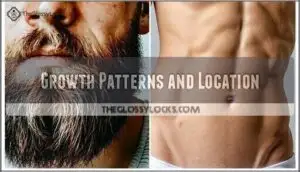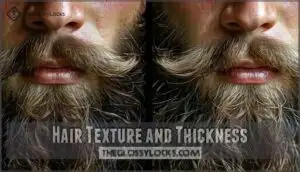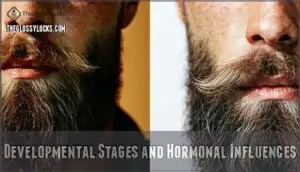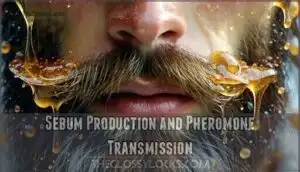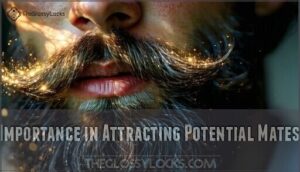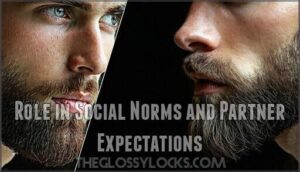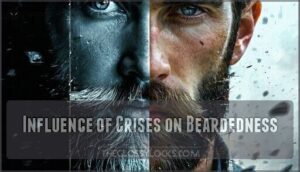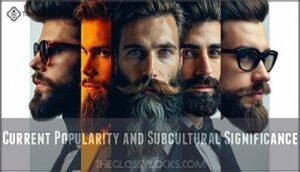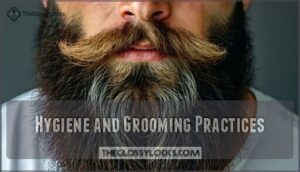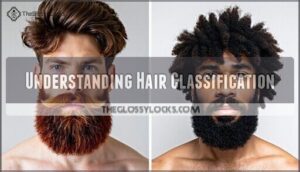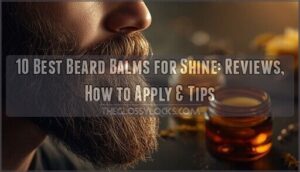This site is supported by our readers. We may earn a commission, at no cost to you, if you purchase through links.
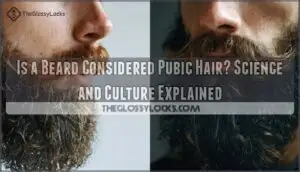
Both are types of terminal hair, meaning they’re thicker and darker than the fine hair on most of your body. They’re also influenced by hormones, especially testosterone, which kicks in during puberty.
The key difference? Location. Beards grow on your face, while pubic hair is, well, down south.
Their texture and growth patterns can vary too—beard hair is often straighter and less curly. So, while your beard might be a cousin to pubic hair, it’s definitely not the same thing. Curious about their biological quirks? Keep reading!
Table Of Contents
- Key Takeaways
- Is a Beard Considered Pubic Hair?
- Beard Hair Vs. Pubic Hair Distinctions
- Sebaceous Gland Similarities
- Hygiene and Grooming Practices
- Understanding Hair Classification
- Frequently Asked Questions (FAQs)
- What is considered pubic hair?
- Does a beard count as hair?
- Is a beard considered body hair?
- Is armpit hair technically pubic hair?
- Why do beards and pubic hair have distinct smells?
- What is the function of sebaceous glands?
- What are pheromones, and how do they work?
- Are beards considered attractive in all cultures?
- How does puberty impact the growth of facial and pubic hair?
- How does beard hair impact skin health?
- Conclusion
Key Takeaways
- Your beard and pubic hair share traits like thickness, coarseness, and hormonal influence, but they’re classified differently based on location and function.
- Beards grow on your face, serve as natural shields, and signal maturity, while pubic hair grows in the genital area and helps reduce friction.
- Sebaceous glands in both areas produce sebum, which keeps hair moisturized and aids in pheromone release, but each has distinct scents due to sweat and bacteria.
- Puberty triggers androgenic hair growth, but beard hair tends to grow denser, darker, and longer compared to pubic hair.
Is a Beard Considered Pubic Hair?
You might wonder if your beard falls into the same category as pubic hair, given their similarities.
While both share traits like thickness and hormonal influence, science classifies them differently based on location and function, considering aspects that distinguish one from the other in terms of function.
Similarities in Hair Composition
When you compare beard hair and pubic hair, their hair composition reveals some surprising similarities.
Beard hair and pubic hair share a surprising kinship in texture and composition, like distant cousins at a family reunion.
Both types are thick and wiry, thanks to follicle composition and the presence of larger hair follicles.
They also share high levels of sebum production, which keeps the hair shaft moisturized and also aids in pheromone release.
This unique feature, influenced by hormonal factors, contributes to their distinct textures and smells.
In basic terms, these two hair types are like distant cousins—different addresses, same family reunion vibes!
Evolutionary and Biological Functions
Looking at evolutionary biology, beards and pubic hair share fascinating biological functions. Both are shaped by androgen stimulation, with testosterone driving their growth during puberty.
These hairs aren’t just for show—they serve mating purposes by aiding pheromone release, signaling sexual maturity in subtle but effective ways. Sebaceous glands in these areas produce sebum, which helps with pheromone transmission, adding to their distinctive smells.
Beyond attraction, they play protective roles: beards shield your face from the elements, while pubic hair reduces friction and irritation. From a biological perspective, these evolutionary functions highlight how hormones craft hair with purpose and practicality.
Cultural and Societal Perceptions
Beards carry different meanings depending on where you’re from.
Beards symbolize strength, rebellion, or wisdom, reflecting cultural identity and personal style across time and traditions.
Some cultures see them as a badge of masculinity and wisdom, while others might associate them with laziness or rebellion.
Grooming trends and societal norms shape these views, often influenced by historical context.
Subcultures embrace beards as a marker of identity, blending style with tradition.
Social interpretations of beards, unlike pubic hair, are deeply tied to visible expression, making them a fascinating mix of personal and cultural symbolism.
Beards can also signal dominance and authority, influencing social interactions and potentially conveying a sense of authority.
Beard Hair Vs. Pubic Hair Distinctions
You might think beard and pubic hair are the same since they share some traits, but they’re quite different.
From growth patterns to texture and hormonal influences, each serves unique purposes in distinct areas of your body.
Growth Patterns and Location
Beard and pubic hair grow in distinct regions, each with unique patterns.
Beard hair thrives on the chin, cheeks, and jawline, while pubic hair is limited to the genital area, including the pubic bone and surrounding skin.
Their growth cycles, follicle distribution, and lengths also differ.
One should also consider the different beard growth stages to understand the full process.
Here’s a quick comparison:
| Feature | Beard Hair Location | Pubic Region Growth |
|---|---|---|
| Growth Area | Face (chin, cheeks) | Genital region |
| Follicle Size | Larger | Smaller |
| Length Potential | Up to 36 inches | 0.5-1.5 inches |
| Growth Pattern | Uniform | Random |
Hair Texture and Thickness
Hair texture and thickness can be a hairy topic, but let’s clear it up. Beard hair stands out for its coarseness and thickness, thanks to larger follicle size and multiple cuticle layers. Pubic hair, while also coarse, has its own hair texture variations and typically feels softer.
Both types are influenced by androgens, which increase hair density and coarseness. You can also find specialized products available designed to improve hair’s fullness. Both types are influenced by androgens, which increase hair density and coarseness.
Here’s a quick comparison:
| Feature | Beard Hair Type | Pubic Hair Definition |
|---|---|---|
| Follicle Size | Larger | Smaller |
| Hair Coarseness | High | Moderate |
| Androgen Influence | Strong | Strong |
| Hair Thickness | Thick | Thicker than scalp hair |
| Hair Density | Dense | Less dense |
Whether shaving or styling, understanding these hair thickness variations can make grooming smoother!
Developmental Stages and Hormonal Influences
Puberty brings a whirlwind of changes, including the growth of androgenic hair like beards and pubic hair.
Thanks to hormonal stimulation, androgen receptors trigger terminal hair development in these areas. Beard follicles, packed with more receptors, respond strongly, producing thicker strands. Pubic hair grows differently—less dense and more scattered.
Beard hair often darkens with age due to follicle changes, while pubic hair stays consistent, driven by genetics. Some individuals explore options like beard enhancement products to influence beard growth.
| Feature | Beard Hair | Pubic Hair |
|---|---|---|
| Growth Density | Dense and uniform | Sparse and scattered |
| Hormonal Sensitivity | High androgen response | Moderate response |
| Color Changes | Darkens with age | Genetically stable |
Sebaceous Gland Similarities
You mightn’t think about it, but your beard and pubic hair have something in common: sebaceous glands.
These glands produce sebum, an oily substance that both keeps hair moisturized and plays a role in pheromone signaling.
Sebum Production and Pheromone Transmission
Sebaceous glands work overtime in areas like your face and groin, producing sebum that carries pheromones.
This glandular activity gives beard and pubic hair their distinctive scent, playing a role in scent perception and mate attraction.
Think of it as nature’s cologne—though not always the most subtle.
These shared traits highlight how sebum composition and pheromone function connect these hair types.
The etymology of "puberty" even stems from Latin roots, reflecting the age of maturity.
Importance in Attracting Potential Mates
Pheromones, nature’s invisible love notes, play a big role in mate attraction.
The sebaceous glands in your beard and pubic hair release these chemical signals, boosting sexual attraction and reproductive fitness.
Here’s how they help:
- Mate selection: Signals health and maturity.
- Pheromone signaling: Enhances evolutionary advantages.
- Sexual attraction: Triggers subconscious interest.
- Reproductive fitness: Indicates genetic quality.
Beards also evolved to enhance perceived male dominance.
Role in Social Norms and Partner Expectations
Beards can feel like a social litmus test. Grooming expectations and partner preferences often shape how facial hair fits into societal norms.
Some see it as a symbol of masculinity, while others view it as scruffy. Beard acceptance also depends on hairstyle trends and cultural perceptions.
Maintaining a beard requires the right tools, so consider a complete beard grooming.
Balancing social pressures with personal style keeps you traversing these social expectations seamlessly.
Historical Trends and Influences
Facial hair has always been more than just whiskers—it’s a statement.
Historical trends show how beards reflected cultural norms and subculture identity.
In ancient Rome, shaving symbolized sophistication, while Protestants later embraced beards to challenge Catholicism.
Beard symbolism often mirrored power, with rulers like Henry VIII setting grooming habits that rippled through societies.
Even crises influence styles; think of soldiers shaving during war for hygiene.
Beards have swung between rebellion and conformity, shaped by societal norms and cultural perceptions.
Whether rugged or refined, a beard’s history is as layered as the follicles that grow it.
Influence of Crises on Beardedness
When life throws curveballs, facial hair often takes center stage. Crises influence grooming habits in fascinating ways, with beards becoming a surprising barometer of societal shifts.
During the COVID-19 pandemic, for instance, concerns about hygiene led many to adopt a clean-shaven look, fearing facial hair might harbor pathogens. Yet, others grew “pandemic beards” as a symbol of resilience or simply because barbershops were closed.
Military regulations during wartime have also shaped beard trends, requiring clean-shaven faces to guarantee gas masks fit properly. Economic downturn beards, on the other hand, often emerge as a response to financial stress, with rugged facial hair signaling adaptability.
- Crisis beard trends often reflect societal uncertainty.
- Pandemic beard growth surged with remote work.
- Wartime beard styles prioritize practicality.
- Economic downturn beards symbolize perseverance.
- Disaster grooming shifts highlight evolving norms.
Current Popularity and Subcultural Significance
In the context of modern masculinity, beard trends highlight subculture identity and evolving social norms.
From hipster beards to competitive grooming, facial hair reflects cultural significance and subcultural significance alike.
It’s a mix of style and status—proof that grooming influence goes beyond aesthetics.
| Beard Style | Cultural Significance |
|---|---|
| Hipster Beards | Rebellion, Individualism |
| Corporate Beards | Authority, Confidence |
| Beard Competitions | Creativity, Community |
| Minimalist Stubble | Modern Masculinity |
Hygiene and Grooming Practices
Keeping your beard clean and well-groomed isn’t just about looks—it’s about hygiene too.
From trimming to choosing the right products, the way you care for your facial hair can make a big difference in its health and appearance.
Hair Removal and Maintenance Considerations
Keeping your beard tidy takes effort, but it’s worth it for hygiene and style.
Hair removal methods like trimming or shaving keep things neat, while proper aftercare routines prevent skin sensitivity and ingrown hairs.
Regular grooming also helps manage hair regrowth, think of it as self-care—your face deserves the same attention as any other part of your personal grooming routine, which includes considering hair removal methods and maintaining proper aftercare.
Impact of Hair Removal Creams and Plucking
Managing beard hair can feel like traversing a maze of options.
Here’s a quick breakdown:
- Trimming: Keeps things sharp and avoids the chaos of wild growth.
- Shaving: A clean slate, but watch for ingrown hair risks.
- Plucking: Ouch! Plucking pain relief is tricky, and it may irritate skin.
- Hair removal creams: Effective but risky—cream chemical burns and skin sensitivity are real concerns.
Always test first to avoid long-term effects. Some creams utilize thioglycolates to dissolve hair.
Smoothness and Hair Removal Alternatives
If you’re after smoothness, there are plenty of hair removal alternatives to explore.
Waxing options give longer-lasting results, while shaving alternatives like trimming are quick and painless.
Laser removal or electrolysis effectiveness might appeal if you want something more permanent.
For a gentler touch, natural depilation methods like sugaring work well.
Whether it’s your beard or pubic hair, the choice depends on your comfort.
Or, skip it all and embrace the natural look—it’s your call!
Understanding Hair Classification
You might think all body hair is the same, but it’s actually classified based on location, structure, and function.
Understanding these distinctions helps clarify why a beard, despite its similarities, isn’t considered pubic hair.
Biological and Evolutionary Perspectives
Puberty triggers androgen influence, sparking changes like beard growth and pheromone release.
Beard hair, like pubic hair, thrives near sebaceous glands, producing sebum that carries mating signals.
This isn’t just biology—it’s evolutionary biology aspects at work.
Beards may have protective roles, shielding your face from sun and debris, while also signaling maturity.
Hair follicle differences explain why beard hair grows longer than pubic hair.
These biological perspectives highlight how hair growth location and follicle development tie into human attraction and survival strategies.
Social and Cultural Interpretations
Beards aren’t just facial hair—they’re loaded with cultural significance and societal influence.
Across history, they’ve symbolized everything from wisdom to rebellion, shaped by cultural beauty standards and societal hair norms.
Here’s how beards fit into social and cultural interpretations:
- Beard Symbolism: Beards often represent masculinity and strength.
- Cultural Norms and Subculture Identity: Grooming trends vary.
- Historical Trends: Beard popularity ebbs and flows.
Think Victorian-era grandeur versus the clean-shaven 1950s.
Today, beards reflect subjective interpretations, blending tradition with modern style.
Some modern styles include a fade with sharp lines.
A clean-shaven look might align with corporate norms, while full beards dominate hipster subcultures.
In some cultures, they’re a mark of maturity or religious devotion, while in others, they’re tied to rugged individuality.
Frequently Asked Questions (FAQs)
What is considered pubic hair?
Pubic hair grows in the genital region, covering areas like the pubic bone and surrounding skin.
It’s denser, shorter, and softer than other body hair, influenced by hormones, and often curly or wavy.
Does a beard count as hair?
Well, unless your beard’s been moonlighting in uncharted territories, it’s just regular facial hair.
Sure, it’s coarse and hormone-driven like pubic hair, but it’s firmly rooted on your face, not your nether regions.
Is a beard considered body hair?
A beard is considered body hair because it grows on the face, part of your body.
It’s androgenic hair, like pubic hair, but it’s not classified in that way.
Think of it as your face’s accessory!
Is armpit hair technically pubic hair?
Ever wonder if armpit hair counts as pubic hair?
Technically, it doesn’t.
While both are androgenic hair influenced by hormones, pubic hair specifically grows in the genital region, whereas armpit hair grows in the axillary area.
Why do beards and pubic hair have distinct smells?
Distinct smells come from sebum and bacteria.
Your beard and pubic hair trap sweat, oils, and pheromones, creating unique odors.
Hormones also play a role, making their smells as personal as your fingerprint.
What is the function of sebaceous glands?
Think of sebaceous glands as tiny oil factories under your skin.
They produce sebum, keeping your hair and skin moisturized, protected, and flexible.
Plus, they play a role in pheromone production, adding unique scents.
What are pheromones, and how do they work?
Pheromones are chemical signals your body releases to communicate with others, often subconsciously.
They can influence attraction, mood, or behavior.
Think of them as nature’s invisible "text messages" in the animal kingdom, which can be seen as a form of communication.
Are beards considered attractive in all cultures?
Around 55% of people find beards attractive, but it varies by culture.
In some places, they symbolize wisdom or masculinity, while others prefer a clean-shaven look.
Beauty standards, like beards, grow and change over time.
How does puberty impact the growth of facial and pubic hair?
Puberty flips the switch on your hormones, triggering testosterone to fuel facial and pubic hair growth.
Androgen receptors activate, making these hairs thicker, coarser, and curlier.
It’s like nature’s way of saying, "Welcome to adulthood!
How does beard hair impact skin health?
Your beard’s like a natural moisturizer, thanks to sebaceous glands producing sebum.
It shields your skin from dryness, sun, and debris, but neglecting hygiene can clog pores, leading to acne or irritation—so keep it clean!
Conclusion
Picture your beard as a unique badge of maturity—it’s not pubic hair, but the two share some intriguing similarities.
Both are terminal hairs guided by hormones like testosterone, yet their location, texture, and societal roles set them apart.
Whether you’re grooming your beard for style or studying its biology, knowing these quirks helps you appreciate its distinct nature.
So, while your beard isn’t pubic hair, it’s definitely part of what makes you, well, you, and contributes to your overall individuality!
- https://www.quora.com/Are-beards-pubes-of-the-face-or-are-pubes-beards-of-the-groin
- https://www.merriam-webster.com/dictionary/pubes
- https://pmc.ncbi.nlm.nih.gov/articles/PMC5928870
- https://blackcombbeards.com/blogs/beard-blog/is-beard-hair-the-same-as-pubic-hair
- https://www.thedermspecs.com/press-articles/expert-explains-why-a-beard-is-technically-pubic-hair-on-your-face

